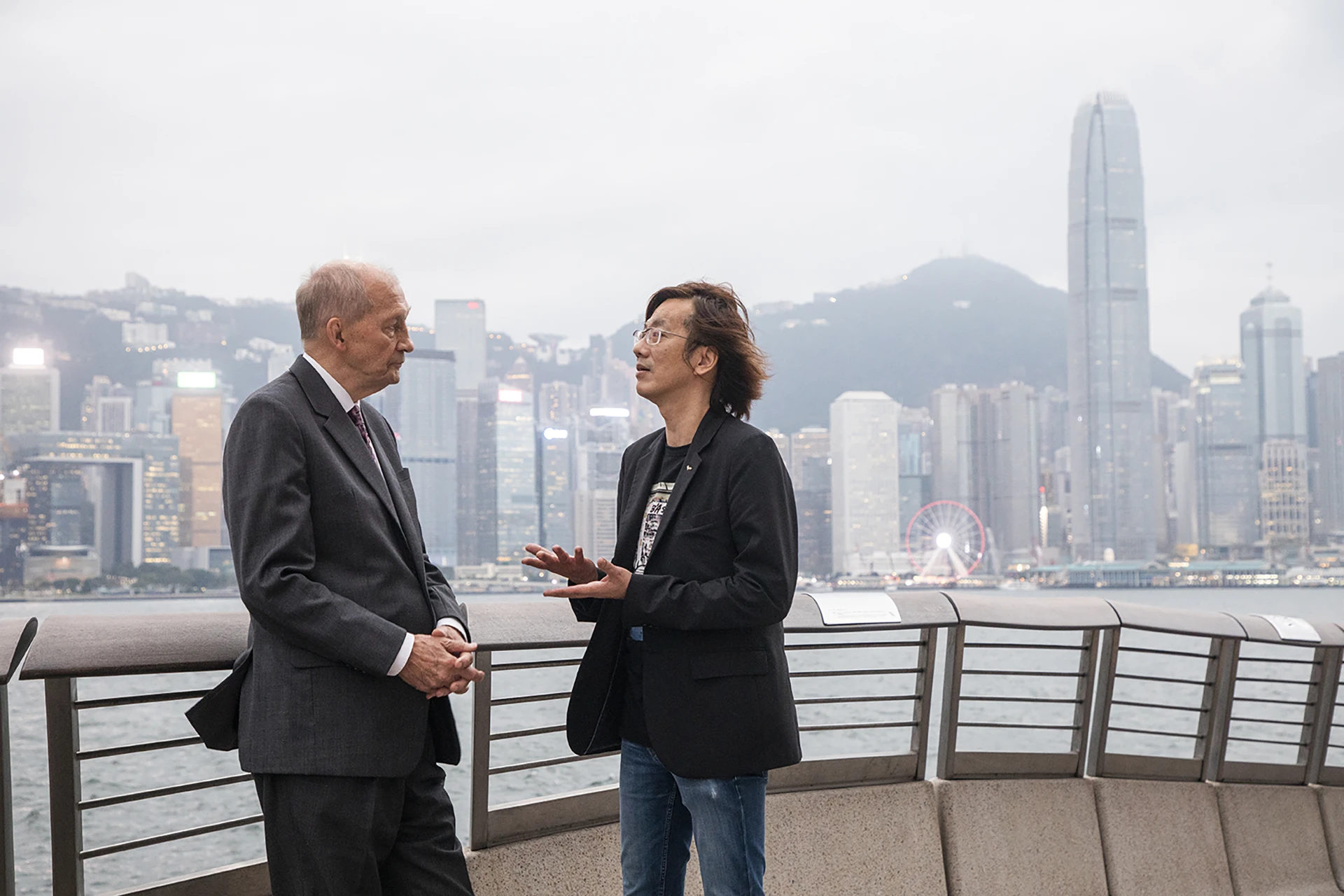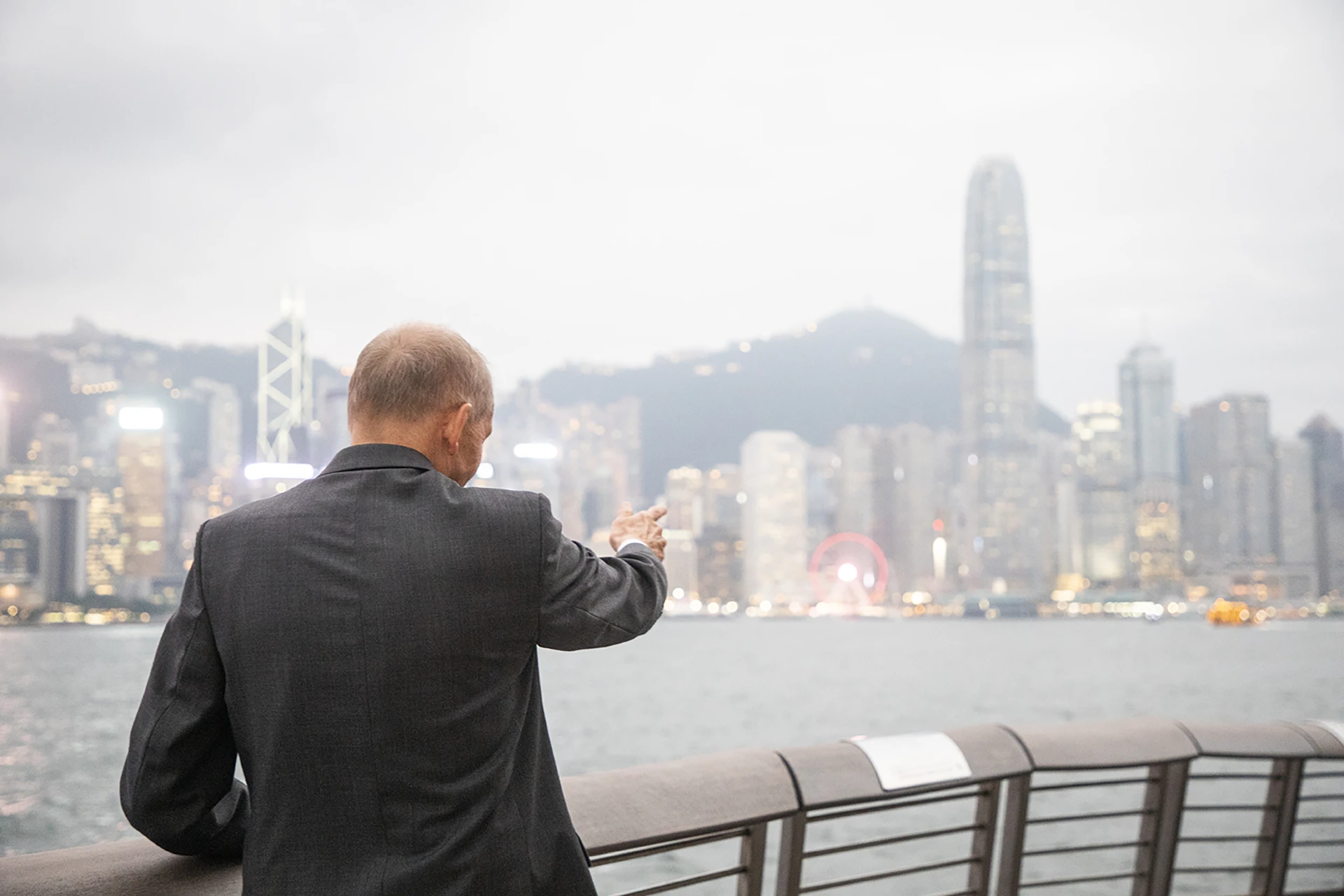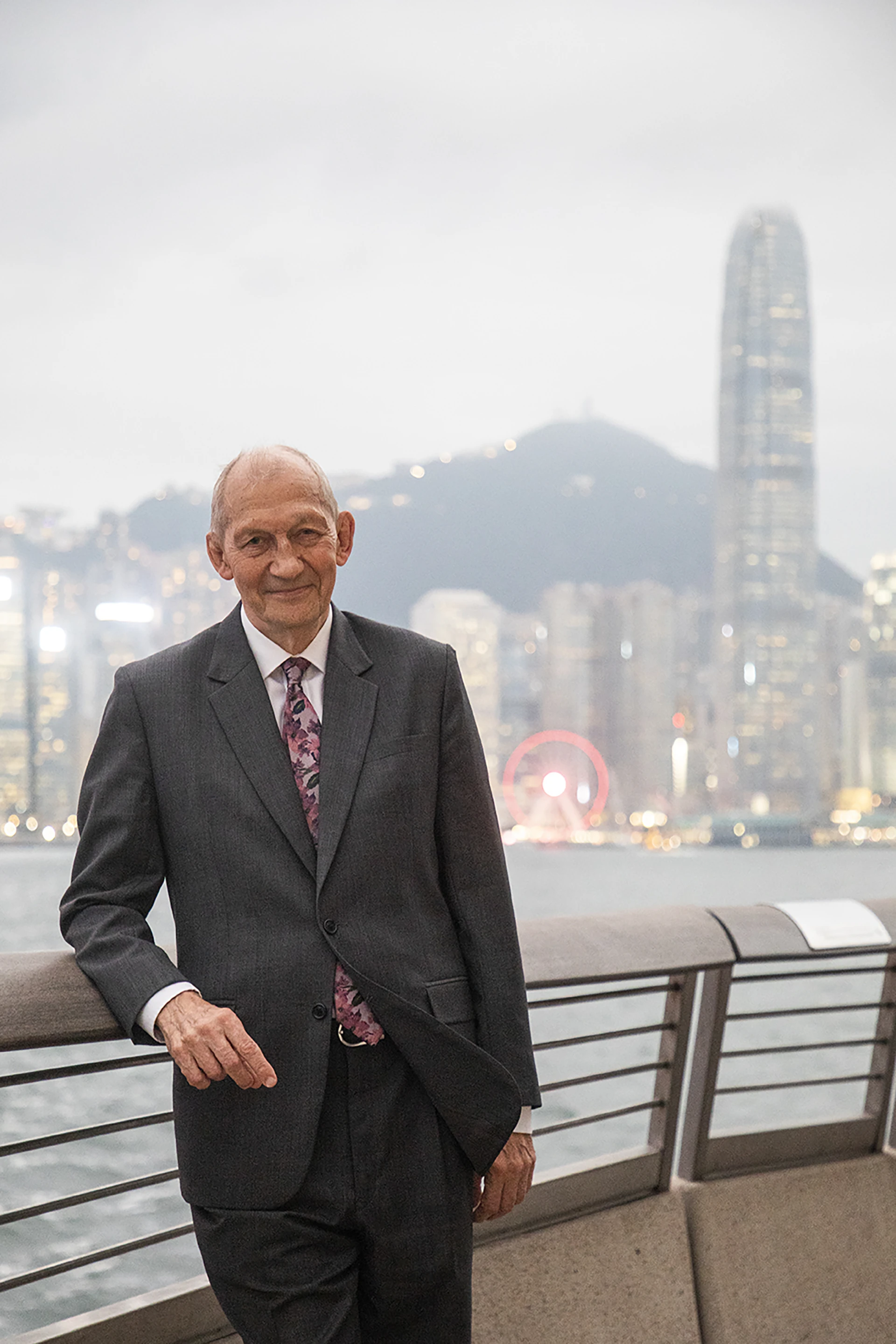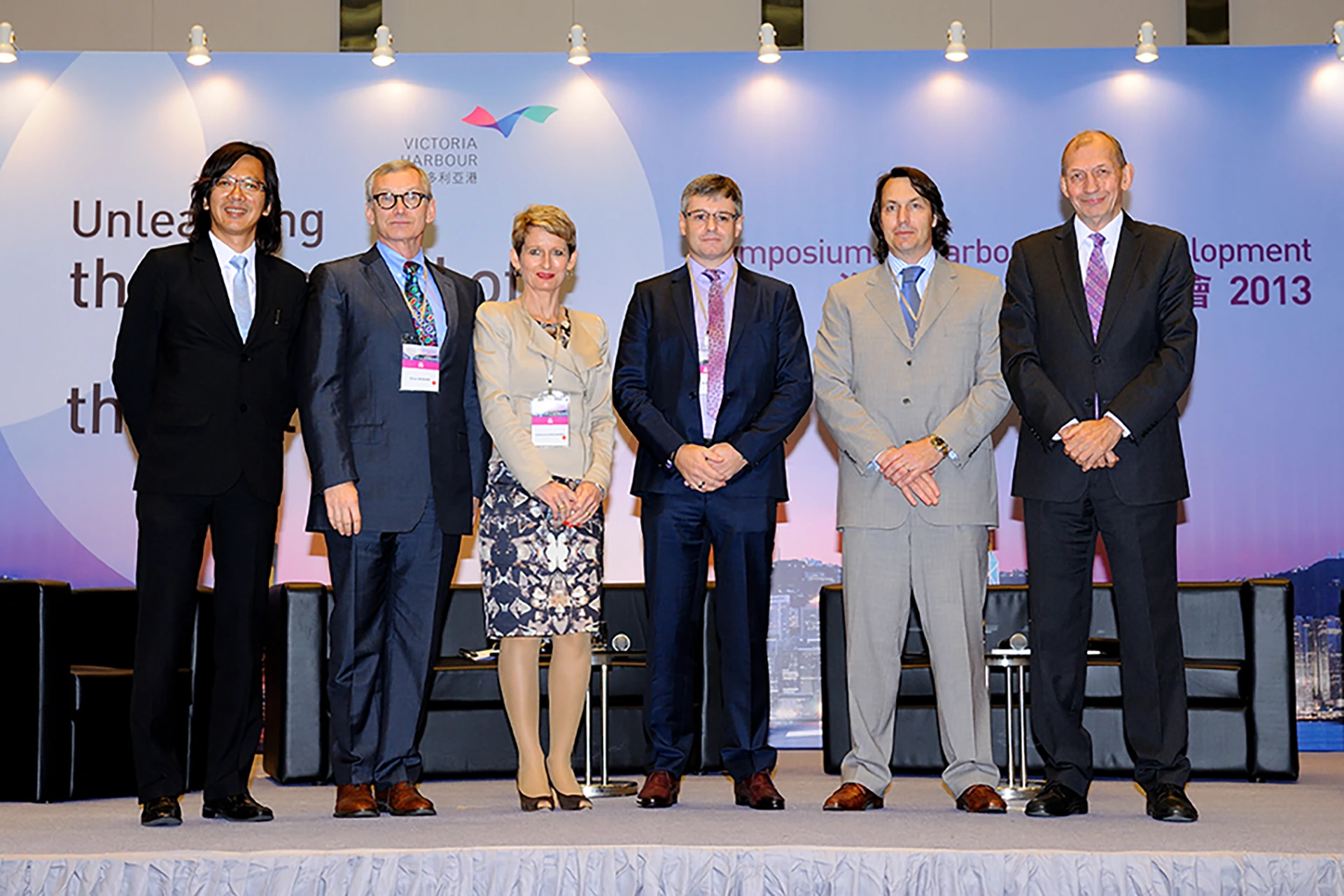Harbour’sTalk:
Sr Nicholas BROOKE and HC Chairperson
The Path of Turning Victoria Harbourfront into a World-Class Asset
Sr Nicholas BROOKE, GBS, JP, FRICS, FHKIS, RPS, was the first Chairperson of the Harbourfront Commission (HC) from 2010 to 2018. Sr BROOKE made significant and important contributions to harbourfront enhancement. Perhaps the most important of all, HC formally adopted the “Vision for the Harbour” in 2010 under Sr BROOKE’s leadership, which seeks to enhance Victoria Harbour (the Harbour) and its harbour-front areas to become “an attractive, vibrant, accessible and sustainable” world-class asset. He also advised the Hong Kong Government on improving the recreational and tourism appeal of the Harbour.
Sr BROOKE, who has lived in Hong Kong for the last 40 years, is a Chartered Surveyor by profession and a Justice of the Peace (JP). He is a recognised authority on land administration and planning matters and is deeply involved with a series of public and private sector initiatives designed to improve the quality of life in Hong Kong and to enhance the built environment for the benefit of future generations.
Mr Vincent NG
Sr Nicholas BROOKE
Enhancing and Enriching Harbourfront as a Whole
Can you tell us about your involvement in the harbourfront development from the very beginning, or even before joining the former Harbour-front Enhancement Committee (HEC)?
Actually, it goes back many, many years. When I first came to Hong Kong, I was employed by Swire Properties as a Deputy Managing Director. One of my main duties was to take forward the master plan for Taikoo Shing, which at that time fronted onto the Harbour on the eastern side of Hong Kong Island. So, right from the start, I had this relationship with the waterfront and the Harbour. I've always believed that the Harbour is fundamental to the success of Hong Kong. It's the signature of Hong Kong in many ways. To me, it has always been important that we recognise and enhance the values of the Harbour.
For many years, it had been quite a struggle to preserve the Harbour because, in the early days, the Government used it as an opportunity to create more land to meet economic and developmental needs; and reclamation was a convenient and readily available means of creating more land. Over the years, I came to the conclusion that we had to say, “enough is enough”. When I was sitting on the Town Planning Board, a proposal was submitted to reclaim the area right through beyond West Kowloon and we decided that the time had come to have a serious conversation with the Government to convey our concerns.
The anti-reclamation lobby became very strong and eventually Ms Christine Loh (the co-founder of the Society for Protection of the Harbour) and other advocates went to the court to establish the presumption against reclamation under the Protection of the Harbour Ordinance (Cap. 531), leading to a moratorium on harbour reclamation unless there was an overriding public need. So, it was the first time we had a fixed coastline.
Right. Previously, we never had a permanent coastline.
Consolidating Experiences and Joining Hands with the Private Sector
As there was to be no more reclamation within the Harbour, we needed to think about how to enhance the established waterfront areas, and how to bring people to the Harbour and the Harbour to the people. We then talked to Mrs Carrie Lam, the then Permanent Secretary for Planning and Lands, who cared a lot about the harbour development. She agreed the need to establish the former HEC as a dedicated committee to monitor and champion harbourfront enhancement and invited Professor Lee Chack-fan to be its first chairperson. The mechanism established by the former HEC and agreed by the Government was that anything that would affect the waterfront had to go through the former HEC. We have been reviewing related proposals since then.
At the beginning, there were only major infrastructure proposals, like the Central-Wan Chai Bypass (Bypass). Initially, the Government wanted to build the Bypass above ground. The former HEC took a solid line in opposing the proposal and suggested that the Government explore alternatives. Eventually, we persuaded the Government to build the Bypass as it is today by taking it all underground.
To further recognise the status of the Harbour and take its development to the next level, Mrs Carrie Lam set up the Harbourfront Commission (HC) to succeed the former HEC and invited me to head the newly formed Commission. That was a big step, giving unprecedented recognition to both the Harbour and such an advisory body. The membership of HC was much more extensive, inclusive, and representative than that of the former HEC, covering a larger group of professionals, interest groups, and the business sector.
With a broader representation and a wider interest, HC was able to be more focused on the details of individual schemes. Given the enormous work, we initially set up three sub-committees for Hong Kong Island, Kowloon and Kai Tak. Then, we created a fourth one focusing on the water-land interface and harbourfront activation, covering common issues affecting the whole of the waterfront.
One of the challenges was that harbour development had taken the form of what might be described as a "jigsaw approach" - there were local and district plans, yet a comprehensive master plan was missing and needed. Victoria Harbour has a total length of about 73 km, which is very long and extensive. So, we also started to press for an overarching master plan. Both of us did a lot of work to look into the best practices of harbourfront spaces worldwide. And we found that the public-private partnership model has been widely adopted and is effective in many ways.
It's good that we touch on this management model. We reckon that the directive management model used by some Government departments may not be suitable for creating a world-class harbourfront like those famous waterfronts worldwide. Although the proposed establishment of a statutory harbourfront authority was not deemed necessary, the Government has set up a Harbour Office under the Development Bureau to coordinate the overall management of the harbourfront areas. It serves like a miniature dedicated Government office to oversee harbourfront developments. At the same time, the private sector has been encouraged to participate in such developments too. How do you see this progress?
My view is that if you want to access the creative juices of the private sector, there must be a variety of forms of partnership with reasonable incentives for the private sector to invest. People get recognition indirectly, not necessarily financially. I think there needs to be real thought about how to engage with the private sector. We should, perhaps, experiment with secondment. If the office was a public and private mixture, you could have people working alongside you from the private sector, or people seconded to your team. Wouldn't it be good to have both the development professionals and people with business acumen in your team?
What can the private sector contribute that the Government cannot do or has limitations on?
Well, I think the private sector has the edge on innovation, creativity and business sense, as it looks at things through different spectacles, including but not limited to a return on investment perspective. I think we are looking for like-minded partners who would share and maximise the opportunity to the benefit of Hong Kong.
Regarding future harbourfront development, we need to introduce an element of excitement and a series of new experiences. For example, you need to do things about food and beverage, and about where to involve the private sector. You have to make the land available somehow, on a sensible basis, and then facilitate a win-win situation for both the private sector and the general public for the benefit of customers/users. You need to be brave in terms of some choices – identify a concept, and approach that particular party about bringing it to the waterfront. That's how the private sector does things. If the concept is extraordinary and proven to be successful in locations beyond Hong Kong, it will be easier to get blessings from everyone to proceed.
A Vision-driven Harbourfront
You have been serving as the HC Chairman for eight years – a long and significant period within those 20 years. Could you identify any event or particular issue that you find most memorable?
To be honest, I gained the most satisfaction from how we managed to create an opportunity for the community at large to participate in the development of this important asset. However, I think we should give credit where credit is due. The Government and various bodies, first the Town Planning Board, and then HC, have all made a significant contribution. I think, on the whole, we have all done pretty well. We could have done better, but for now, let’s recognise that we have made a huge amount of progress. We have a well-respected Commission that influences the outcome of virtually every development along the harbourfront. So that's all very positive. But we still have to work a lot harder to achieve the status of a world-class waterfront.
In my view, the community is delighted with what HC and the Harbour Office have done. What shall be the next focus for us moving forward?
Along Victoria Harbour, we have worked very hard to link the waterfront to the hinterland, and to connect the waterfronts; but there are still pockets where accessibility could be improved. We should do our best to improve the connectivity. And then, we could work on creating diversity along the waterfront. So perhaps, in five-years’ time, it would be possible to say we have a world-class waterfront – we should have such a goal. Indeed, it is not just about creating open space. You need a variety of attractions. Creating diversity along the waterfront is another key. We are very lucky because the Harbour is so special, and people will remember the Harbour. I think if we can enhance the waterfront, it will really add to the experience, and make the experience even better.
In terms of the future, we could engage the youth through competitions in the planning and management of the waterfront, empower them to take charge of some tasks and let them assume ownership and accept responsibility and be accountable while growing with the Harbour. I think that would gain momentum.
In addition, I think we should learn from and capitalise on the opportunities presented by the Guangdong–Hong Kong–Macao Greater Bay Area (GBA). It would be great to borrow ideas and insights from the GBA, such as the waterfront development in Shenzhen.
I think we need to have a paradigm shift in the mentality. Conventionally, the common practice was prioritised for ease of management. Nowadays we are talking about people-oriented, customer-focused experiences, but not the other way around. HC, as well as the Harbour Office, are now advocating a more vision-driven approach.
It is all about experience. We should try and introduce more “wow factors” all the way around. We can stimulate and create all kinds of experiences. We can also simply provide places where people can sit or walk comfortably and get a good meal or a glass of wine etc., and gain access easily.
How do you see the branding and marketing efforts of Hong Kong’s harbourfront areas across the planning, design and engagement stages?
We talked about the harbourfront being a signature of Hong Kong. Why don’t we use the Harbour as part of the promotion? I would be happy to see more harbour-related content being used in the public relations (PR) materials to promote Hong Kong. It is a fantastic sales pitch. I would have this on every single piece of the city-wide PR material. If we want to promote our city, we should think of tourism and business visitors in the widest sense. Hong Kong is a very special city with a very special harbour.
Reviewing the last 20 years of harbourfront development, we have plenty of achievements and some remain to be completed. What is your general thought and sentiment about it?
I think we have come a long way notwithstanding that we were a bit slow off the mark to start with. We had to go through the reclamation experience. We had to have debates about authorities and all the rest. Yet, we have done pretty well in terms of catching up. The work of HC has shown dividends, and we are now looking at a wide range of successful initiatives all around the harbour. It has been a very successful partnership with the Government. I think the important thing is we have learnt as we moved along.
All of these wouldn’t be possible without the commitment and determination of every previous and present members – who are a bunch of very passionate and knowledgeable people from different sectors and professions.
Yes, we should recognise the constructive contributions of the members of the former HEC and HC. People come to HC with their own views and priorities. But they share a common goal to make things better. Perhaps we should try and persuade members to be a little bit more aspirational, a little more ambitious. Hopefully, in five years, Victoria Harbour will rank as a world-class waterfront with its own unique characteristics. Then, people from around the world would remember Hong Kong because of our unique harbour.



